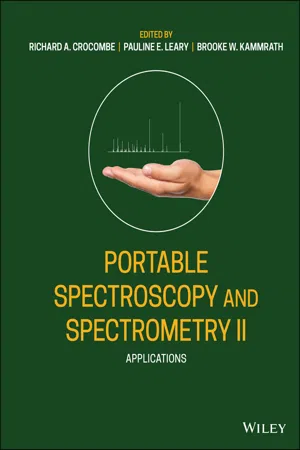
Portable Spectroscopy and Spectrometry, Applications
- English
- ePUB (mobile friendly)
- Available on iOS & Android
Portable Spectroscopy and Spectrometry, Applications
About this book
The most comprehensive resource available on the many applications of portable spectrometers, including material not found in any other published work
Portable Spectroscopy and Spectrometry: Volume Two is an authoritative and up-to-date compendium of the diverse applications for portable spectrometers across numerous disciplines. Whereas Volume One focuses on the specific technologies of the portable spectrometers themselves, Volume Two explores the use of portable instruments in wide range of fields, including pharmaceutical development, clinical research, food analysis, forensic science, geology, astrobiology, cultural heritage and archaeology.
Volume Two features contributions by a multidisciplinary team of experts with hands-on experience using portable instruments in their respective areas of expertise. Organized both by instrumentation type and by scientific or technical discipline, 21 detailed chapters cover various applications of portable ion mobility spectrometry (IMS), infrared and near-infrared (NIR) spectroscopy, Raman and x-ray fluorescence (XRF) spectroscopy, smartphone spectroscopy, and many others. Filling a significant gap in literature on the subject, the second volume of Portable Spectroscopy and Spectrometry:
- Features a significant amount of content published for the first time, or not available in existing literature
- Brings together work by authors with assorted backgrounds and fields of study
- Discusses the central role of applications in portable instrument development
- Covers the algorithms, calibrations, and libraries that are of critical importance to successful applications of portable instruments
- Includes chapters on portable spectroscopy applications in areas such as the military, agriculture and feed, hazardous materials (HazMat), art conservation, and environmental science
Portable Spectroscopy and Spectrometry: Volume Two is an indispensable resource for developers of portable instruments in universities, research institutes, instrument companies, civilian and government purchasers, trainers, operators of portable instruments, and educators and students in portable spectroscopy courses.
Frequently asked questions
- Essential is ideal for learners and professionals who enjoy exploring a wide range of subjects. Access the Essential Library with 800,000+ trusted titles and best-sellers across business, personal growth, and the humanities. Includes unlimited reading time and Standard Read Aloud voice.
- Complete: Perfect for advanced learners and researchers needing full, unrestricted access. Unlock 1.4M+ books across hundreds of subjects, including academic and specialized titles. The Complete Plan also includes advanced features like Premium Read Aloud and Research Assistant.
Please note we cannot support devices running on iOS 13 and Android 7 or earlier. Learn more about using the app.
Information
1
The Role of Applications in Portable Spectroscopy
1.1 Introduction
1.2 The Evolution of Applications




Table of contents
- Cover
- Table of Contents
- Title Page
- Copyright
- Dedication
- List of Contributors
- Foreword
- Preface for Volume 2
- Acknowledgements
- 1 The Role of Applications in Portable Spectroscopy
- 2 Identification and Confirmation Algorithms for Handheld Analyzers
- 3 Library and Method Development for Portable InstrumentationA Case Study Approach
- 4 Applications of Portable Optical Spectrometers in the Chemical Industry
- 5 The Value of Portable Spectrometers for the Analysis of Counterfeit Pharmaceuticals
- 6 Forensic Applications of Portable Spectrometers
- 7 Military Applications of Portable Spectroscopy
- 8 Applications of Ion Mobility Spectrometry
- 9 Portable Spectroscopy in Hazardous Materials Response
- 10 Toward Clinical Applications of Smartphone Spectroscopy and Imaging
- 11 Applications of Portable and Handheld Infrared Spectroscopy
- 12 Spectra Transfer Between Benchtop Fourier‐Transform Near‐Infrared and Miniaturized Handheld Near‐Infrared Spectrometers
- 13 Applications of Handheld Near‐Infrared Spectrometers
- 14 X‐Ray, LIBS, NMR, and MS Applications in Food, Feed, and Agriculture
- 15 Portable Near‐Infrared Spectroscopy in Food Analysis
- 16 Handheld Raman, SERS, and SORS
- 17 Portable Raman Spectroscopy in Field Geology and Astrobiology Applications
- 18 Hyperspectral Proximal Sensing Instruments and Their Applications for Exploration Through Cover
- 19 Handheld X‐Ray Fluorescence (HHXRF)
- 20 XRF and LIBS for Field Geology
- 21 Portable Spectroscopy for Cultural HeritageApplications and Practical Challenges
- 22 Portable Spectroscopy for On‐Site and In Situ Archaeology Studies
- 23 The Future of Portable Spectroscopy
- Index
- End User License Agreement